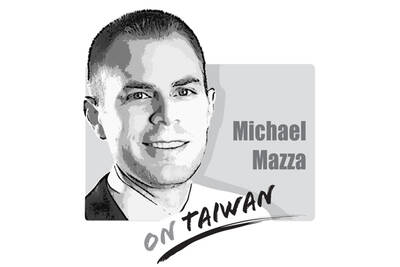It has been an epic display of brinkmanship.
The US State Department, after perhaps a year of holding up processes that would have delivered promised arms to Taiwan, has relented and will reactivate the deals prior to the US presidential election, possibly allowing delivery to be approved by Congress before the current session ends.
The reasons for the reversal are unclear at this time, though pressure had been building on the State Department over the status of the arms for an extensive period — pressure from Taiwan lobbyists in the Congress, from military sources, from Paul Wolfowitz in his capacity as chairman of the US-Taiwan Business Council and as a foreign policy hawk and, ironically enough, from the Chinese Nationalist Party (KMT) government after years of blocking the deal in opposition.
In recent months it became clearer that moves were under way behind the scenes to get this problem fixed before US President George W. Bush ends his presidency. Wolfowitz, for one, was oddly optimistic in a speech in Taipei in July, linking passage of the deal to Bush’s personal honor. Wolfowitz might have known something that most others did not; even think tank identities with extensive connections in the US political and military spheres had grown awfully pessimistic as time wore on.
The importance of the effort to unfreeze the arms deal cannot be understated as far as US foreign policy is concerned. As a number of analysts have suggested, leaving the problem to next year would have left both a Republican and Democratic president with an unnecessary burden. Starting a term as US president by releasing arms to Taiwan would be far more damaging to US-China ties than releasing them in the dying days of the current presidential term.
The release of arms also lets the next president craft a China policy relatively unsullied by the ham-fisted behavior of everyone involved in recent years.
As encouraging as the news is, the State Department’s decision is more than likely to have been motivated by limiting damage with China rather than optimizing Taiwan’s ability to defend itself. In this respect Taiwan continues to fall behind and rapidly so, not just in terms of arms procurements and combat readiness but also in terms of the ideological hollowness of Taiwan’s government, the political exhaustion of ordinary people and President Ma Ying-jeou’s (馬英九) refusal in rhetorical and practical terms to treat Taiwan as a genuine polity and Taiwanese people as his compatriots and masters.
Such national symbolism, or its weakness, is no small matter. At the same time that the weapons issue is being brought to a head, voices in Congress are making louder noises about Taiwan’s commitment to its relationship with the US amid Taipei’s attempts to mollify and move closer to Beijing.
Many members of Congress could be criticized for failing to heed warnings of Ma’s ideological handicap in this regard, but in the end Taiwanese must look to themselves, not overseas, for the real reasons that China is growing as a threat every day. Lulled by habit and pragmatism, Taiwanese remain vulnerable on too many fronts.
In the near future, however, it is hoped that the State Department, which has so much influence over policy and its implementation, can play a more constructive and supportive role in US-Taiwan relations than it has done under the Bush administration.
The government and local industries breathed a sigh of relief after Shin Kong Life Insurance Co last week said it would relinquish surface rights for two plots in Taipei’s Beitou District (北投) to Nvidia Corp. The US chip-design giant’s plan to expand its local presence will be crucial for Taiwan to safeguard its core role in the global artificial intelligence (AI) ecosystem and to advance the nation’s AI development. The land in dispute is owned by the Taipei City Government, which in 2021 sold the rights to develop and use the two plots of land, codenamed T17 and T18, to the
Taiwan’s first case of African swine fever (ASF) was confirmed on Tuesday evening at a hog farm in Taichung’s Wuci District (梧棲), trigging nationwide emergency measures and stripping Taiwan of its status as the only Asian country free of classical swine fever, ASF and foot-and-mouth disease, a certification it received on May 29. The government on Wednesday set up a Central Emergency Operations Center in Taichung and instituted an immediate five-day ban on transporting and slaughtering hogs, and on feeding pigs kitchen waste. The ban was later extended to 15 days, to account for the incubation period of the virus

The ceasefire in the Middle East is a rare cause for celebration in that war-torn region. Hamas has released all of the living hostages it captured on Oct. 7, 2023, regular combat operations have ceased, and Israel has drawn closer to its Arab neighbors. Israel, with crucial support from the United States, has achieved all of this despite concerted efforts from the forces of darkness to prevent it. Hamas, of course, is a longtime client of Iran, which in turn is a client of China. Two years ago, when Hamas invaded Israel — killing 1,200, kidnapping 251, and brutalizing countless others
US President Donald Trump has announced his eagerness to meet North Korean leader Kim Jong-un while in South Korea for the APEC summit. That implies a possible revival of US-North Korea talks, frozen since 2019. While some would dismiss such a move as appeasement, renewed US engagement with North Korea could benefit Taiwan’s security interests. The long-standing stalemate between Washington and Pyongyang has allowed Beijing to entrench its dominance in the region, creating a myth that only China can “manage” Kim’s rogue nation. That dynamic has allowed Beijing to present itself as an indispensable power broker: extracting concessions from Washington, Seoul